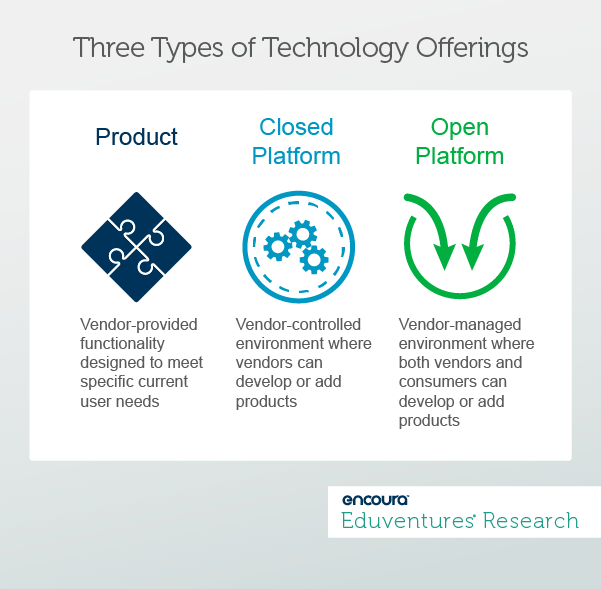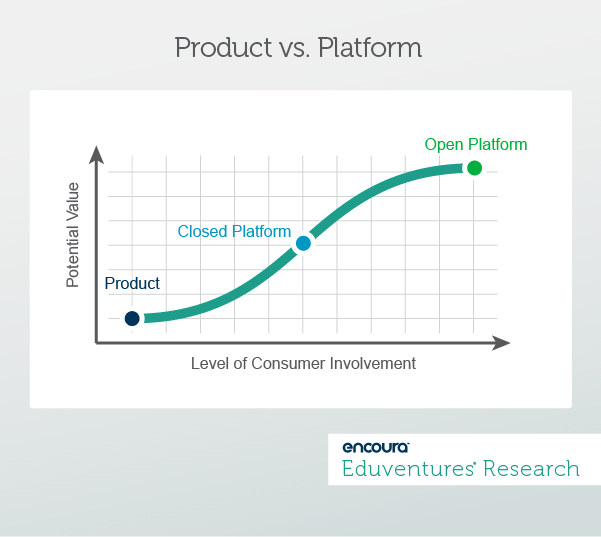Imagine what your iPhone would be like if Steve Jobs had—according to Walter Isaacson’s biography—succeeded in disallowing the open-platform App Store. We wouldn't have edtech platforms like today. How long would it have taken before we had apps to stream music, use social media, or read breaking news? Would Apple have anticipated these needs and developed them before we lost interest in the iPhone?
In higher education technology, most vendors operate on Jobs’ original model: consumers may inform the functionality of their products, but only vendors produce functionality. Is there a better way?
Most of the time, this model works perfectly well. Many education technology products on the market today provide much-needed functionality to help institutions deliver value in admissions, enrollment, and teaching and learning. But in areas like competency-based education, for example, many have found a significant gap between what they need and what their current solutions provide.
We think an alternative approach—similar to the App Store—is one where institutions and vendors contribute functionality to meet known and unknown needs. This approach, which we call an “open platform,” allows institutions to position themselves and their technology solutions to develop an App Store-like model, enabling both the host vendor and other vendors to come together to
Figures 1 and 2 identify three types of technology offerings: products, closed platforms, and open platforms.

- Products: Like the vast majority of the participants in our Tech Landscape, products are vendor-designed, vendor-managed, and deliver a specific set of functionality to meet user needs.
- Closed Platforms: Closed platforms enable the vendor, and only the vendor, to develop, add, and extend the functionality of its products.
- Open Platforms: Similar to closed platforms, open platforms enable the development, addition, and support of functionality, but they also allow both producers (vendors) and consumers (users) to do so.

We should note two caveats. One, the distinction between products and platforms is not always mutually exclusive. Facebook, for example, is both a product (the application upon which we read our user feed) and an open platform (the different games and surveys that developers create for Facebook to deliver to its users).
Also, in making this distinction, it does not at all mean that we think products provide “less” value. Rather, as in other industries, we believe an openness to allowing the contribution of functionality from producers and consumers also holds significant potential for meeting current and future needs of higher education.
Vendors to Watch
We see four vendors and one technology segment poised to help institutions use platforms to meet current and future challenges:
Acquia
As a web content management system, Acquia Cloud enables institutions to deliver, store, and manage digital content across the enterprise. It also offers much more. As a true open platform offering, Acquia Cloud empowers institutions to leverage the open-source Drupal content management framework and the strong Drupal user community to build or reconfigure websites to address changes in branding and digital engagement needs.
D2L
Both a product and a platform, D2L’s Brightspace Learning Environment enables institutional leaders and third-party vendors to develop applications and widgets on its platform. Recognizing that no learning management system alone can meet the varied and changing requirements of a full learning ecosystem (like serving different user types), D2L has created a solution that users can adapt to meet these changing demands.
Salesforce
Like D2L, Salesforce offers both a product and an open platform. Its constituent relationship management solution, Salesforce for Higher Education, not only provides functionality across the student lifecycle, but allows users to develop their own applications—either for their use or for the use of others via the App Store. Similar to Drupal, Salesforce has a devoted user community, which assists those new to developing Salesforce-based applications with best practices and answers.
ModoLabs
The world of mobile applications development in higher education primarily focuses on the development of mobile apps to assist in recruiting students or helping students navigate onboarding. ModoLabs goes beyond this. Similar to Acquia Cloud, its open platform also allows colleges and universities to realize a digital engagement strategy by the development, testing, and management of mobile applications.
Application Development Solutions
The most open of open platform offerings, these cloud-based solutions exist solely to empower users to develop, run, and manage applications without having to manage the underlying infrastructure (data centers, etc.). Although little-used by institutions right now, Microsoft’s Azure, Google’s Cloud Platform, Oracle’s Cloud Platform, and others offer potent capabilities to institutions looking to develop, manage, and deploy all types of applications.
We will track the development of open platforms closely in our upcoming research. Our hope is that institutions explore these platforms as they seek to develop their own App Store approach to address current and future needs.
Thursday August 29, 2019 at 2PM ET/1PM CT
Much has been said about the characteristics and preferences of Gen Z, but new Eduventures research unveils that vast differences exist even within this generation. From distinct search strategies to micro-generational behaviors and attitudes, recruitment outreach needs to be more personalized than ever. Learn which outreach strategies help your marketing team engage the right students at the right time, and understand what many students wish colleges and universities got right.

